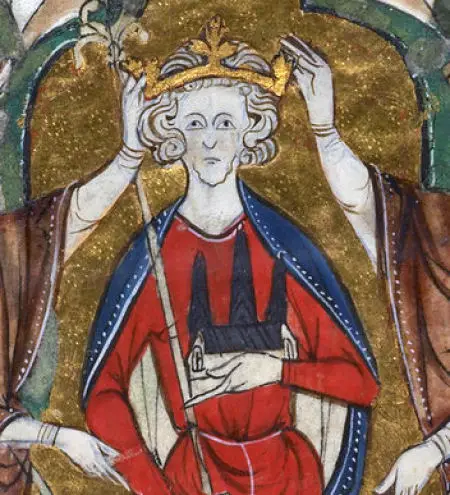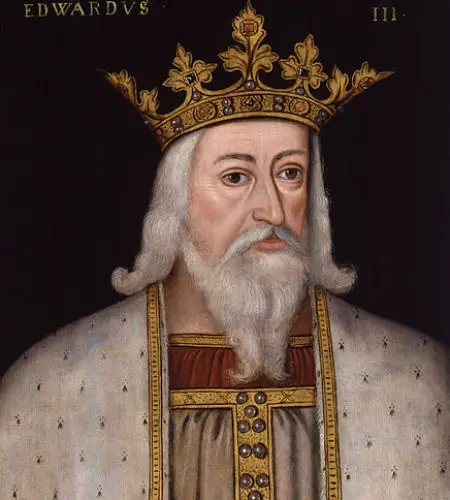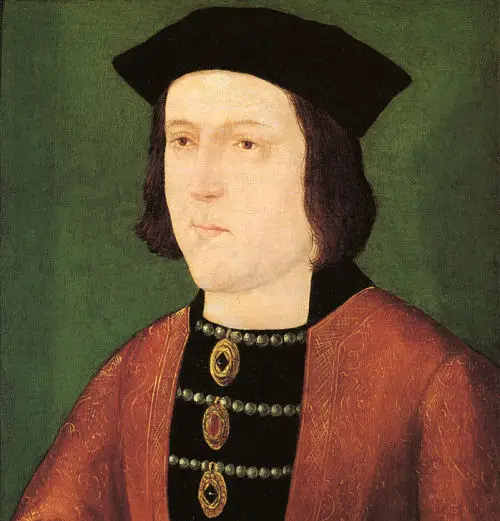The House of Plantagenet Family Tree below details all Kings of England from 1154 – 1485 and their direct descendants.
In this House of Plantagenet Family Tree, Kings of England are capitalized and coloured blue. Direct descendants of the House are capitalized in black while spouses are shown in black and lower case.

What is the House of Plantagenet?
The House of Plantagenet ruled England for just over 300 years. It is sub-divided into four sections:
- Those early Plantagenets that also ruled Anjou, known collectively as the House of Angevin – 1154-1216.
- The main branch of the House of Plantagenet – 1216 – 1399
- The cadet branch of the Plantagenets known as the House of Lancaster – 1399 – 1461, 1470
- The cadet branch of the Plantagenets known as the House of York – 1461 – 1470, 1471 – 1485
The accession of the first Plantagenet, King Henry II, in 1154 ended the rule of the House of Normandy.
History of the House of Plantagenet
The House of Plantagenet was named after Geoffrey of Anjou who had the habit of wearing a sprig of broom (planta genista) in his hat. Geoffrey married Empress Matilda, daughter and nominated heir of King Henry I of England. After the death of Henry I, Matilda did not succeed to the throne, her cousin, Stephen of Blois took the throne beginning a period of Civil War between them, known as the Anarchy.
The war was prolonged but largely indecisive. Matilda did not manage to unseat Stephen, but an agreement was eventually reached whereby Stephen would reign until his death but he would be succeeded by Matilda and Geoffrey’s son Henry Plantagenet.
The Angevin Branch of the Plantagenets 1154 – 1216
(see main article House of Angevin Family Tree)
The first Plantagenet rulers are collectively known as the House of Angevin because they ruled over the vast Angevin Empire in addition to ruling England. King Henry II had inherited Anjou from his father, Normandy from his mother and Aquitaine through his marriage to Eleanor of Aquitaine.

King Henry II was considered a formidable ruler and with the help of his friend, Thomas Becket, managed to implement many governmental reforms. However, his appointment of Becket as Archbishop of Canterbury soured their friendship. Becket’s murder in 1170 shocked the Christian world.
Henry’s relationship with his sons was also problematic, largely due to Henry’s reluctance to share power with his heirs.
When Henry died in 1189, he was succeeded by his eldest surviving son, Richard the Lionheart. King Richard I was noted for his military prowess and also for taking part in the Third Crusade. However, Richard was often absent from England and his capture and ransom on return from Crusade led to a decline in the economy.
Richard died in 1199 and was succeeded by his younger brother, King John. John was a weaker ruler than his brother and was unable to withstand challenges by Philip II or his own nobles. In 1203, English overlordship of the Brittany was lost.
The demands of the English nobility for reform left John without backing for a campaign against Philip II of France and by 1204, John had lost control of Normandy, Anjou, Maine and Touraine to the French king. Conflict with the Barons continued to increase and in 1215 John was forced to sign the Magna Carta which defined individual freedoms and implemented the rule of Law. John’s repudiation of Magna Carta led to the First Barons’ War.
The Main Plantagenets 1216 – 1399
In 1216 King John was succeeded by his nine year old son Henry III. For the first years of Henry’s reign, government was in the hands of Regent, William Marshal who reinstated Magna Carta ending the First Barons’ War.

After Henry came of age his reign was characterized by continuous conflict with the English barons. In 1258, the Barons, led by Simon de Montfort, forced through the Provisions of Oxford which established a council to oversee the King’s decisions. However, Henry III repudiated the Provisions of Oxford in 1261 which led to further conflict and the outbreak of the Second Barons’ War in 1264. During the war Simon de Montfort gained control and established a representative parliament in 1265 before being defeated at the Battle of Evesham in 1265.
Henry III’s son, King Edward I was a strong king known for his military campaigns against Wales and Scotland, earning him the nickname “Hammer of the Scots.”
He reinstated the power of the monarch through the Statutes of Westminster, which reformed land tenure and curbed abuses by feudal lords. He also reformed Parliament, establishing it as a central institution in English governance.
King Edward II, son of Edward I, became King in 1307. Unlike his father, Edward lacked military and political acumen, and his reign was marked by favouritism, rebellion, and ultimately, deposition.
The favours given to Piers Gaveston and later the Despenser family, by Edward II, alienated the Barons and his wife Isabella. His lack of military acumen resulted in defeat at the Battle of Bannockburn in 1314.
In 1326, Queen Isabella and her lover, Roger Mortimer, invaded England, captured Edward and forced him to abdicate in favour of his son.
In 1327, King Edward III succeeded as king at the age of fourteen years. His mother and Roger Mortimer ruled as Regents due to Edward’s age. However, within three years he had overthrown the Regents and taken control of government. Mortimer was executed and his mother removed from court.

In 1337 Edward declared himself the rightful King of France, arguing that through his mother he took precedence over the accession of King Philip VI. The French disagreed resulting in the beginning of the Hundred Years’ War between England and France. The English saw victories at Sluys (1540), Crécy (1346) and Calais (1347). However by the 1370s the war had turned in France’s favour.
In 1348 the Black Death reached England. The plague had profound social, economic, and political impacts at home as well as disrupting Edward’s ambitions in France.
Edward’s later years were overshadowed by personal tragedy, including the death of his wife, Philippa of Hainault, and his eldest son, Edward the Black Prince as well as his own declining health. He delegated much authority to his son, John of Gaunt, Duke of Lancaster, rather than sharing it between his sons which led to factions within the family and political instability.
When Edward died in 1377, the throne passed to his ten year old grandson, King Richard II. John of Gaunt acted as head of a regency government during Richard’s minority. In 1381 at the age of fourteen, Richard faced the Peasants’ Revolt, a massive uprising fuelled by economic hardship and resentment over taxation. He bravely met with rebel leaders and promised reforms but later reneged, crushing the rebellion with force.
When Richard came of age his reliance on a small circle of loyal advisors and his use of royal prerogative alienated much of the nobility. In 1399, Richard exiled Henry Bolingbroke, son of John of Gaunt, and confiscated his inheritance. Many nobles took Bolingbroke’s side and when he invaded England in 1399 he was able to capture Richard and force him to abdicate. Henry Bolingbroke took the throne as King Henry IV, the first king of the House of Lancaster.
The House of Lancaster 1399 – 1461, 1470
(See main article Houses of Lancaster and York Family Tree)
From the beginning, King Henry IV faced the challenge of legitimising his claim to the throne over that of Edmund Mortimer, the eight year old son of Roger Mortimer and Alianore Holland who was Richard II’s designated heir. In 1403 he defeated Henry Percy, nicknamed Hotspur, at the Battle of Shrewsbury.
A prolonged conflict in Wales with Owain Glyndwr and his failing health meant Henry IV was unable to resume the Hundred Years’ War with France.
In 1413, Henry’s son succeeded as King Henry V without incident. Henry was a proven military leader and wasted no time in trying to regain control in France. English success at the Battle of Agincourt in 1415 and further French defeats, contributed to the agreement of the Treaty of Troyes in 1520. The treaty was sealed with the marriage of Henry to Catherine of Valois with agreement that their heirs would inherit England and France.

Henry died of dysentery in 1422. His son became King Henry VI at just nine months old. A few months later King Charles of France died and Henry became King of France. His uncle, John, Duke of Bedford acted as Henry’s regent in France while another uncle, Humphrey Duke of Gloucester acted as Regent in England.
Bedford’s Regency in France was challenged by the Dauphin, Charles, Duke of Orleans, who, with the support of Joan of Arc, succeeded in reclaiming most of France by 1453.
Henry suffered periods of mental instability and his ability to rule was challenged by Richard Duke of York, son of Anne Mortimer and Richard of Conisburgh (both descendants of Edward III). This led to the outbreak of the Wars of the Roses. Richard Duke of York was killed at the Battle of Wakefield in 1460 but his son, Edward successfully defeated Henry VI and took the throne in 1461.
The House of York 1461 – 1470, 1471 – 1485
(See main article Houses of Lancaster and York Family Tree)
King Edward IV, son of Richard Duke of York, became King after defeating Henry VI at the Battle of Towton. Edward worked to secure his position by defeating Lancastrian supporters and rewarding his loyal Yorkist allies. However, Edward’s secret marriage to Elizabeth Woodville in 1464 alienated his powerful ally, Richard Neville, Earl of Warwick (known as “Kingmaker”), who had hoped to arrange a politically advantageous match.

In 1470, Warwick allied with Edward’s younger brother, George, Duke of Clarence against Edward IV and Henry VI was reinstalled as King. The following year Edward returned. Warwick was killed at the Battle of Barnet, Henry VI’s son Edward was killed at the Battle of Tewkesbury. Henry VI, imprisoned in the Tower of London was killed and George Duke of Clarence was executed.
With the elimination of challenges to the throne, the remainder of Edward IV’s reign was peaceful. His unexpected death in 1483 led to his thirteen year old son becoming King Edward V. Edward’s uncle, Richard Duke of Gloucester was nominated Regent and he placed the young king and his brother Richard in the Tower of London. They were never seen again.
In June 1483 Richard Duke of Gloucester had been made aware of a precontract between Edward IV and Eleanor Butler. This rendered his marriage to Elizabeth Woodville null and void and their children illegitimate. Richard then took the throne as King Richard III.
Richard’s reign was marred by distrust due to his perceived usurpation and the mysterious disappearance of the “Princes in the Tower.” The sole Lancastrian claimant was Henry Tudor, son of Edmund Tudor and Margaret Beaufort (descendant of John of Gaunt). Tudor had fled to France following the Yorkist succession in 1461. Richard tried unsuccessfully to have Henry Tudor returned to England.
Henry’s mother, Margaret Beaufort made an agreement with Edward IV’s widow, Elizabeth Woodville that if Henry Tudor became King he would marry her daughter Elizabeth of York.
Henry Tudor invaded England in 1485. Richard was defeated and killed at the Battle of Bosworth Field and Henry was proclaimed King. He was the first king of the House of Tudor.
Complete list of Plantagenet Kings 1154 – 1485
Angevin Branch
King Henry II
Duke of Normandy 1150-1189, Count of Anjou 1151-1189, Duke of Aquitaine 1152-1189, King of England 1154-1189
King Richard I
Duke of Normandy 1189-1199, Count of Anjou 1189-1199, Duke of Aquitaine 1189-1199, King of England 1189-1199
King John
Duke of Normandy – 1199-1204, Duke of Aquitaine 1199-1216, King of England 1199-1216
Main Plantagenet Kings
King Henry III 1216 – 1272
King Edward I 1272 – 1307
King Edward II 1307 – 1327
King Edward III 1327 – 1377
Richard II 1377 – 1399
Lancastrian Branch
King Henry IV 1399 – 1413
King Henry V 1413 – 1422
King Henry VI 1422 – 1461, 1470
Yorkist Branch
King Edward IV 1461 – 1470, 1471 – 1483
King Edward V 1483
King Richard III 1483 – 1485
Published Nov 28 2024 – Updated – Dec 16 2024
Harvard Reference for House of Plantagenet Family Tree:
Heather Y Wheeler. (2024 – 2025). House of Plantagenet Family Tree 1154 – 1485. Available: https://www.treesofblue.com/house-of-plantagenet-family-tree-1154-1485. Last accessed March 16th, 2025
